MARIANI’SVirtual
Gourmet
January
26, 2014
NEWSLETTER
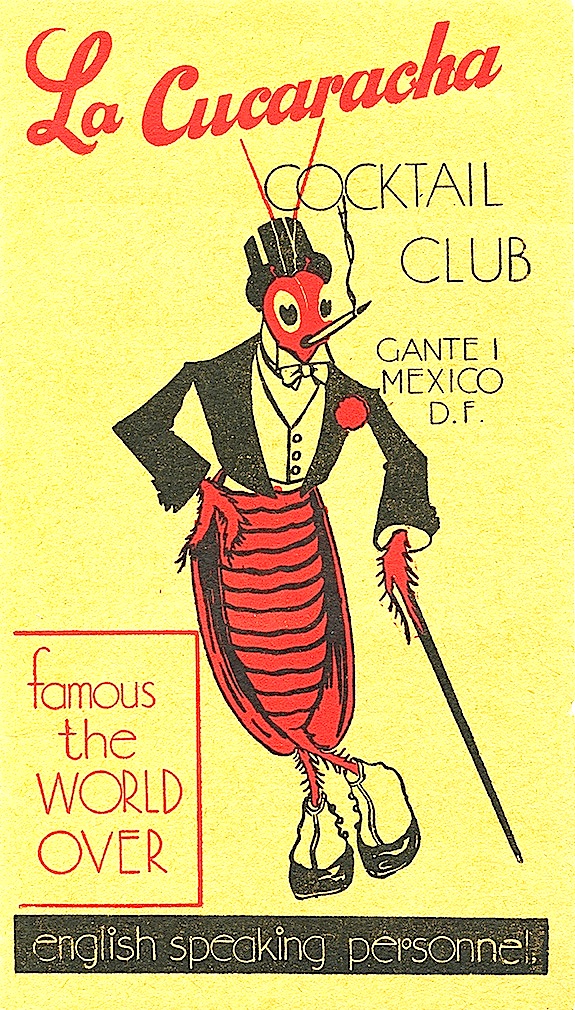
Mexico City
Restaurant Menu circa 1935
ANNOUNCEMENT: FOOD FIGHT!

On Tuesday, Feb. 4 at 6 PM, the International Culinary Center in NYC will hold a lively debate on the subject "Culinary Technology: A FAD...or the FUTURE?"--whether MODERNIST CUISINE is a flash in the pan or an integral part of cooking fundamentals, moderated by Dorothy Cann Hamilton, Founder and CEO of International Culinary Center. Join the strongly opinionated panelists:

“The fact is, despite tremendous media hype… the
expansion and influence of avant garde cuisine has
been next to zero."
--John
Mariani, columnist for Esquire and author of the new Encyclopedia of
American Food & Drink.
“Mariani's remarkable
contention that avant garde cuisine has had no
influence is so far off base as to be absolutely
stunning.”--Colman Andrews, editorial director, The Daily Meal,
and author of The
Taste of America and Ferran: The Inside
Story of El Bulli and the Man Who Reinvented
Food.
6:00pm classic + techie cocktails; Debate
begins promptly at 6:30pm in the Amphitheater at the
International Culinary Center, 462 Broadway, 2nd
floor. Please RSVP by January 27 to
klaux@culinarycenter.com or call 646-254-8577.
❖❖❖
THIS
WEEK
WHAT'S NEW IN ARIZONA?
By John Mariani
NEW YORK CORNER
NERAI
By John Mariani
THE WORLD’S BEST SELLING COOKIE
MAKES A VERY CURIOUS CHANGE
By John Mariani
NOTES FROM THE WINE CELLAR
WHAT'S
THE
OUTLOOK FOR WINE IN 2014?
By
John
Mariani
❖❖❖
WHAT'S NEW IN ARIZONA?
By John Mariani

I
first set foot in Scottsdale and Phoenix in 1977,
while driving across the country on a 14-week
honeymoon. After wending our way through the South
and barreling on through Texas, I was aware I was in
a new kind of western territory, one where people
were wholly willing to take chances and open to
innovation, while still preserving the long, often
sacred, traditions of the region.
I was
also very impressed by the food scene in Phoenix and
Scottsdale back then, at a time when few American
cities had much to brag about in their staid
gastronomy. Of course, if you used the Mobil Guide
back then, restaurants in the Valley of the Sun
seemed almost a satire on fast food Americana.
But I recall some very fine restaurants, like
Durant’s Steakhouse (then already 37 years old), the
Orangerie at the Arizona Biltmore, Mandarin Inn,
Etienne’s, the superb nouvelle cuisine restaurant
Vincent’s on Camelback, and one of the best Italian
restaurants of its day, Ianuzzi’s (where an
excellent bottle of 1967 Barolo cost $17). Since
then, the region’s gastronomy has grown hugely in
quality and stature.
My favorite time to go to Arizona
is not in
mid-summer, when it's 110 degrees outside. "But it's
dry heat!"
the locals scream. So is a pizza oven's. So the only
thing to do, as I did when there last summer, was to
stay inside until time for lunch and dinner, when I
could venture out, crank up the a/c in the car and
rush into a nice, cool restaurant. Here are
some of the places I found to be welcome relief from
the Scottsdale/Phoenix summer.
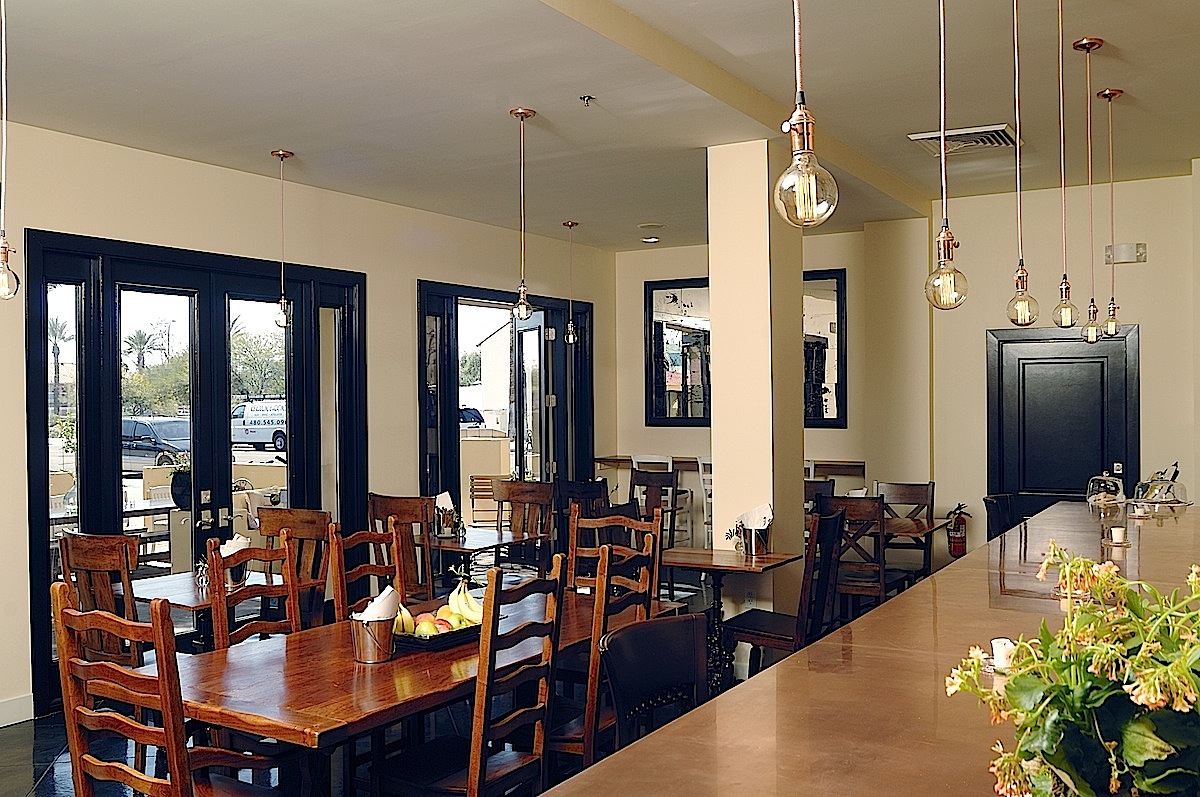 Virtù Honest
Craft
Virtù Honest
Craft
in the Bespoke Inn
3701 North Marshall Way
Scottsdale, AZ
480-946-3477
virtuscottsdale.com
The
place where I spent most time inside was the Bespoke Inn (below) which is a
good deal more than a bed-and-breakfast and well shy
of a formal hotel. Its luxury is evident in the
attention to personalized detail owners Kate and Rob
Herren put into every inch, from the comforters to the
soaps, from the books and toys on the shelves to the
polished nickel fixtures. There is an infinity edge
lap pool and you may ride British Pashley bicycles
free of charge (even if it’s 110 degrees outside).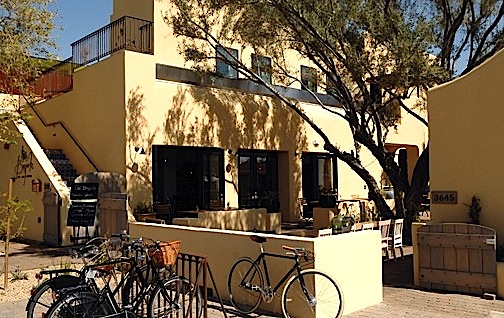
Downstairs
are three bedrooms and upstairs the Signature Flat,
where I was so happy to stay, furnished with high
ceilings and reclaimed wood floors, with a fabulous
kitchen with a marble island and handmade walnut farm
table. Daily brunch at Virtù downstairs
is part of the room rate.
Kate
and Rob--you’ll be immediately on a first name
basis--are eager to tend to your wishes, and you’d
have to think long and hard to come up with a request
they will not grant. When a taxi did not arrive
on time to take me to the airport, Kate just shrugged
and said, “Hop in the car. I’ll run you over.” More
generous, more congenial, more amiable innkeepers
cannot be.
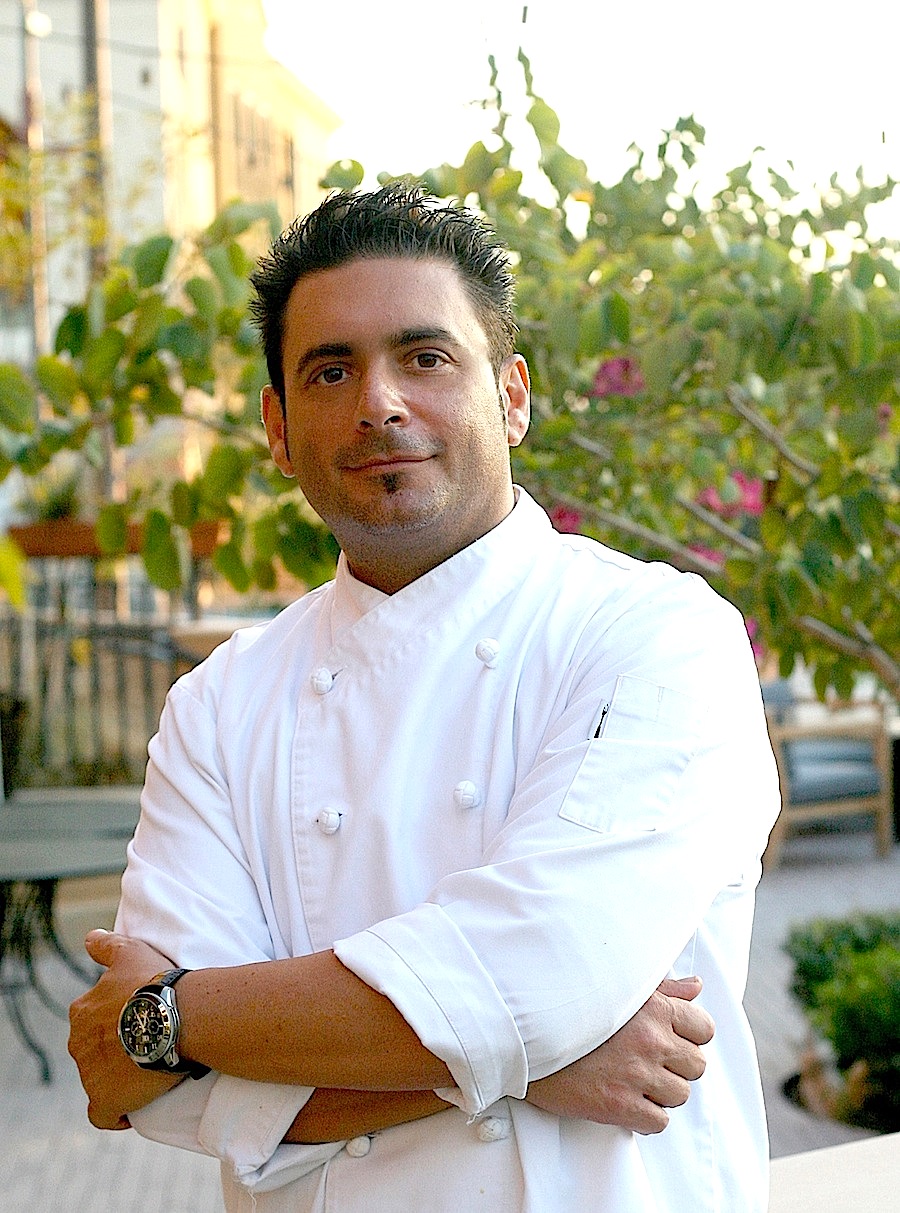 As for the Virtù
Honest Craft restaurant (above), I’ve
long admired the inventive Southwestern cooking of
Chef Gio Osso (left),
and now he’s proven himself one of America’s
finest interpreters of Mediterranean food, albeit
with Arizona swagger, evident in a starter like
his beautiful fried squash blossoms plumped up
with pecan goat’s cheese, local lemon-scented
honey and chopped chives. The food looks, as
fine dining is supposed to look, but the laid-back
vibe of the place, with just 25 seats and a
bar, puts off all notions of pretentiousness.
As for the Virtù
Honest Craft restaurant (above), I’ve
long admired the inventive Southwestern cooking of
Chef Gio Osso (left),
and now he’s proven himself one of America’s
finest interpreters of Mediterranean food, albeit
with Arizona swagger, evident in a starter like
his beautiful fried squash blossoms plumped up
with pecan goat’s cheese, local lemon-scented
honey and chopped chives. The food looks, as
fine dining is supposed to look, but the laid-back
vibe of the place, with just 25 seats and a
bar, puts off all notions of pretentiousness.
It’s always
evident when a chef cooks what he himself loves to
eat, leading to dishes like Osso’s grilled orata coated
with lemon-oregano crumbs and sided with a Calabrese peperonata with
a scorpion’s bite. He makes his own
cream-centered burrata
and chile butter, whips fat-mottled mortadella salame
into a puree to be spread on smoky country bread, and
reduces cherries, hazelnuts and chocolate to make a
sour-sweet gianduja
sauce to lavish on his smoked duck with toasted cumin
and cashew tabbouleh of bulghur wheat.
Virtù has a lot of buzz among local chefs, who
sit at the bar, order a Virtù Starter Kit
cocktail of Cocchi vermouth, Plymouth gin, grapefruit
bitters and bitter lemon soda, and nod to each other
as they eat Osso’s food, looking for ideas.
Open
for brunch and dinner daily; Appetizers $7-$15, main
courses $18-$29.
BINKS MIDTOWN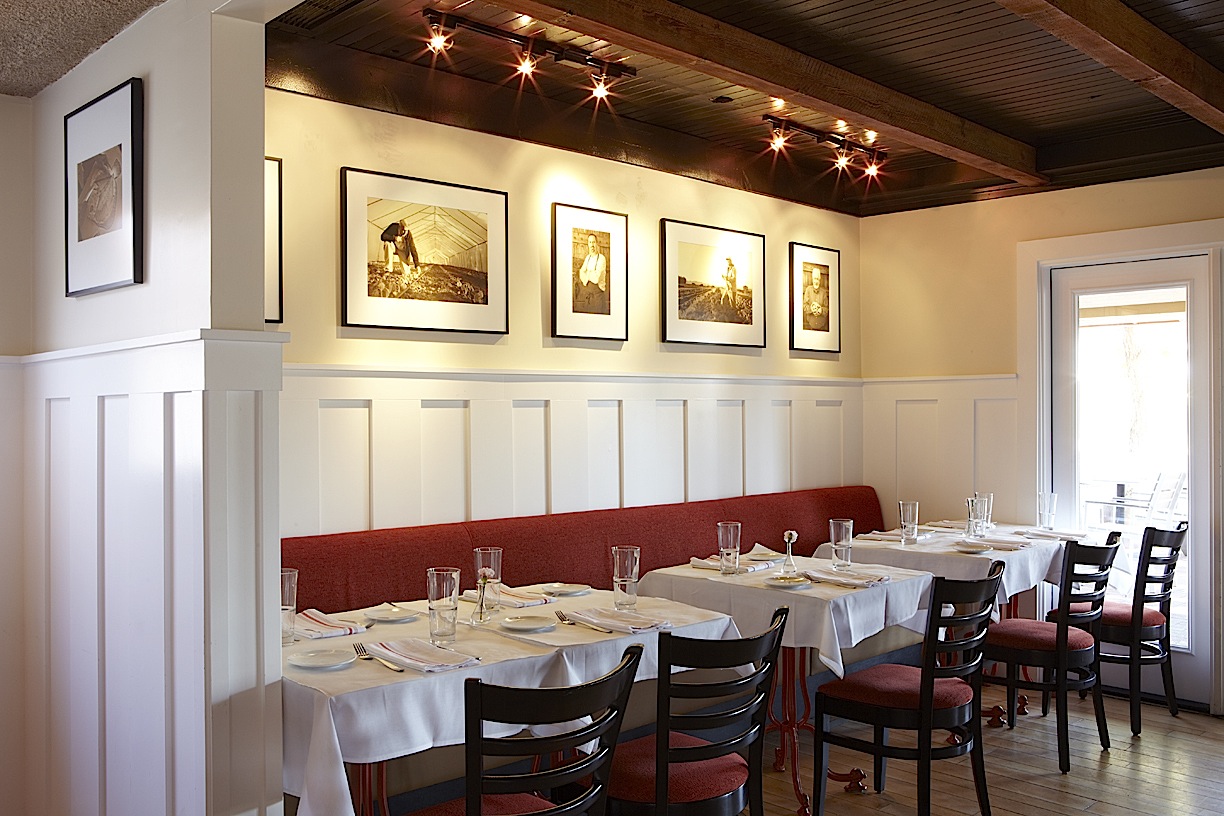
2320 E. Osborn Road, Phoenix
602-388-4874
binksmidtown.com
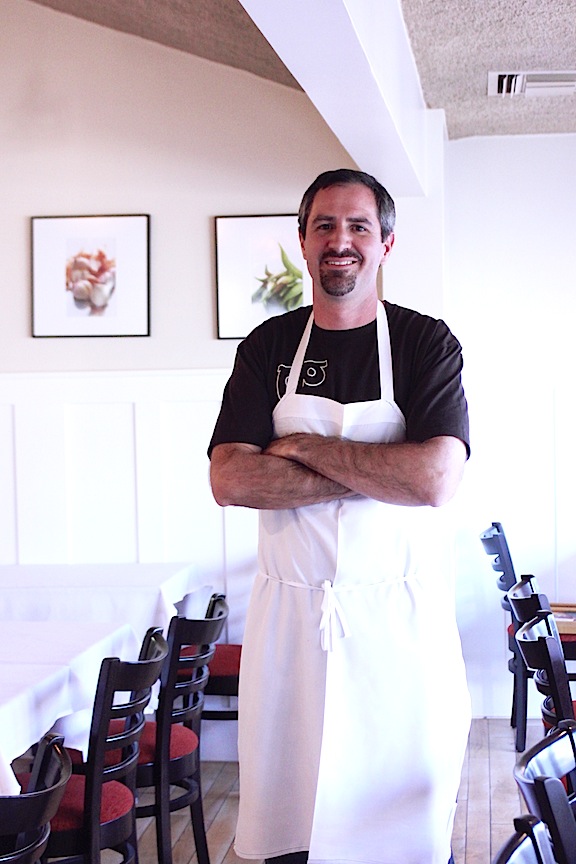 Kevin
Binkley (left)
has an indisputable reputation as one of the Valley's
most creative chefs, best evidenced at his first
restaurant, Binkley's
up in Cave Creek, where he serves long tasting menus
of highly refined cuisine. He also runs the
delightful Café
Bink in Carefree, where the food is admirably
simple and so satisfyingly good. His newest
place, Bink's Midtown, despite its inane name, is a
fine marriage of both his creativity and his idea that
food should indeed have simple virtues, an attitude
reflected within the white wooden walls of a modest
house in Phoenix.
Kevin
Binkley (left)
has an indisputable reputation as one of the Valley's
most creative chefs, best evidenced at his first
restaurant, Binkley's
up in Cave Creek, where he serves long tasting menus
of highly refined cuisine. He also runs the
delightful Café
Bink in Carefree, where the food is admirably
simple and so satisfyingly good. His newest
place, Bink's Midtown, despite its inane name, is a
fine marriage of both his creativity and his idea that
food should indeed have simple virtues, an attitude
reflected within the white wooden walls of a modest
house in Phoenix.
I was there for lunch and ordered a
slew of items, beginning with deep-fried baby back
ribs with a tamarind, sesame and yogurt dipping
sauce--a dish no one but a vegan could possibly be
immune to. Green chile pork papusa came
with an assertive salsa
verde cut by a tangy apple and peppery
radish, and a plate of sweetbread nuggets, creamy and
served with a sweet-and-sour Gen. Tso’s-like sauce,
peanuts and scallions, went fast at my table. Burrata
cheese was an option, 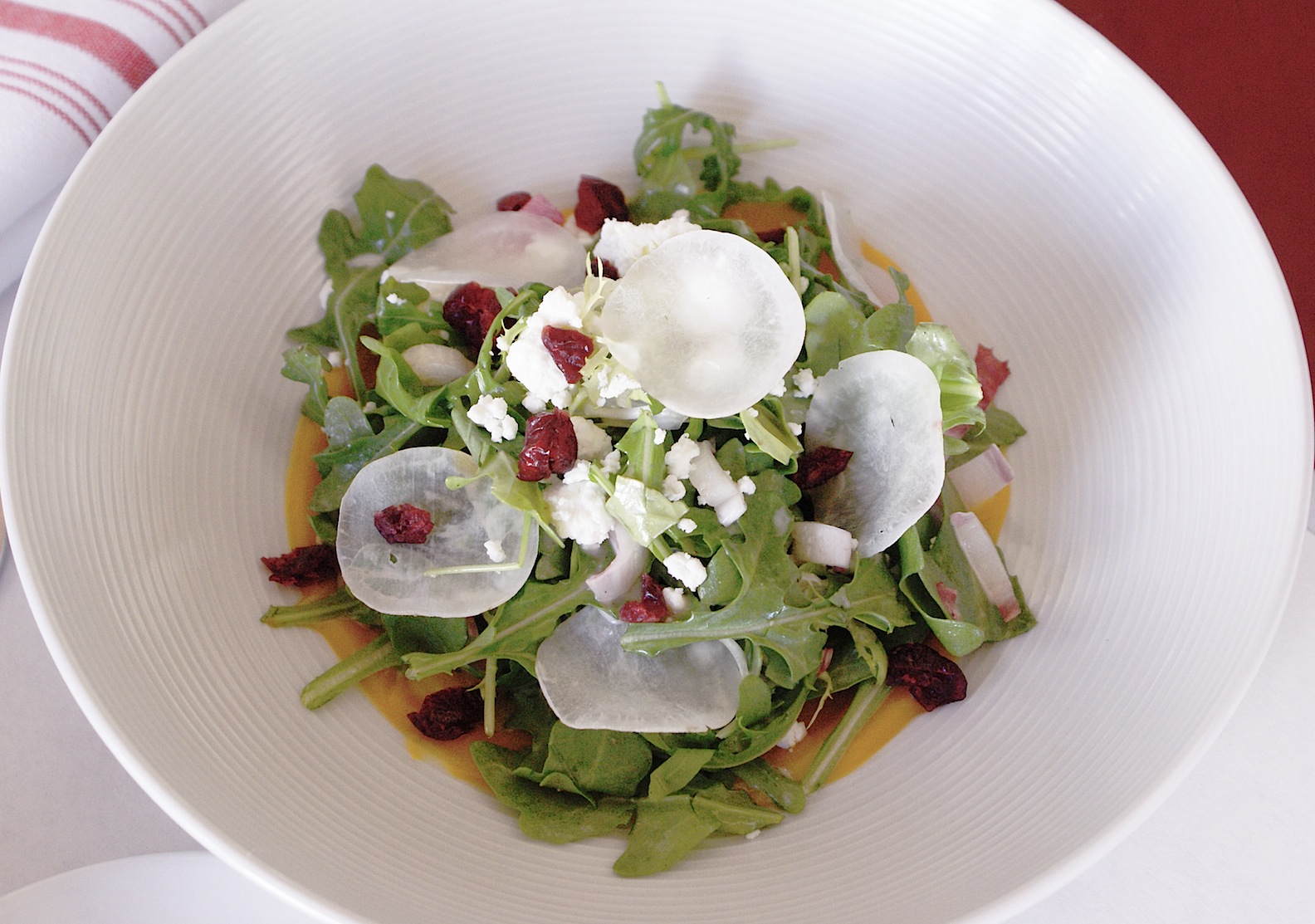 with pistachios, breadstick,
and peach preserves, but it came out ice cold, when it
should have been at least room temperature.
with pistachios, breadstick,
and peach preserves, but it came out ice cold, when it
should have been at least room temperature.
You so rarely see sand dabs on a
menu--if you do, it’s probably in a San Francisco
restaurant--so, when I do, I order them. Binkley’s
were terrific, tender, sweet and dressed in plenty of
brown butter with almonds.
I enjoyed my lunch but can imagine
that at twilight, as the Arizona sky starts to turn
colors, Binks Midtown is an enchanting place to have a
long, lingering romantic dinner.
Open daily for lunch and dinner; appetizers at dinner $4-$21, main courses $16-$22.
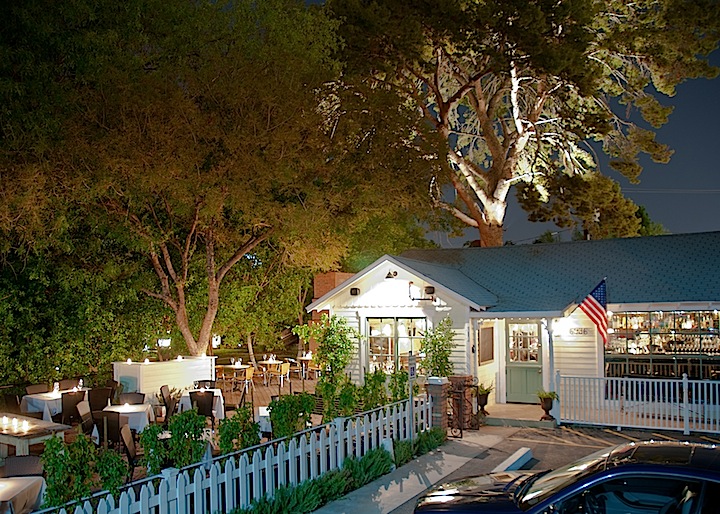
THE HOUSE BRASSERIE
6936 East Main Street
Scottsdale, AZ
480-634-1600
thehousebrasserie.com
The
House Brasserie doesn’t look quite like any other
restaurant in the area, unless you can find a place
with flocked gold wallpaper, Victorian mirrors, and
crystal chandeliers. It’s possible a silver mine
magnate’s house might once have 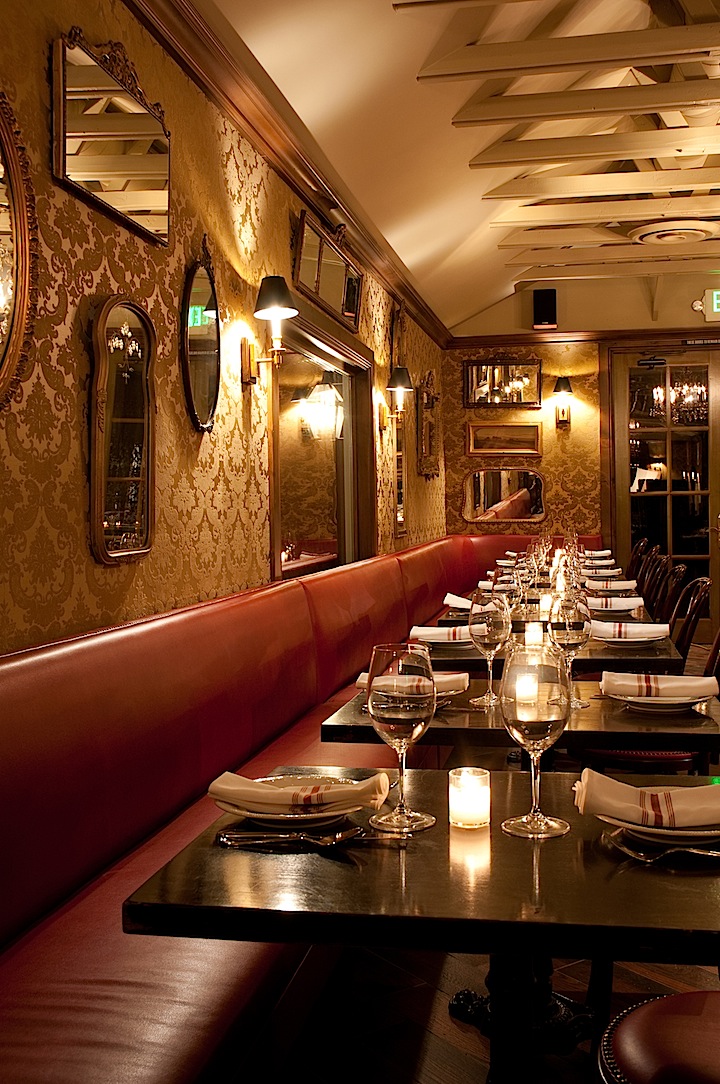 looked
something like this, but otherwise it’s actually very
comfortable and not in the least stuffy. The
website says it’s “grandmotherly.”
looked
something like this, but otherwise it’s actually very
comfortable and not in the least stuffy. The
website says it’s “grandmotherly.”
I enjoyed
the Mexican food Chef Matt Carter was doing at The Mission,
but here he has fanned out to more global cuisines on
a menu that is too large by half to do everything
equally well. But I dined with gusto and
satisfaction, beginning with crab fried rice, properly
runny mollet egg and amarillo chile, a diverting
Arizona-Asian concept. There is also a generous
selection of domestic salamis ($16), and I’m sure
salad lovers will enjoy the one here with gem lettuce,
heirloom tomatoes, avocado, roast corn, smoked pasilla
chile and lime vinaigrette, a dish that really
succeeds at every level of taste and texture.
I wasn’t
mad about the bland crispy pork rillettes with blue
cheese, but crisp, hot jerk chicken had a lot of punch
going for it, with cashews, banana, and smoked grapes,
and the pork belly took on Korean notes of kimchee, udon
noodles, and a fried egg. Crab with a smoked
Gouda fondue, roast peppers and cilantro made for a
perfect lunch dish, and for dessert you’d have to go
far to find better than the caramel upside down apple
cake with salted caramel and pistachio ice cream.
Open for lunch and dinner daily; appetizers $4-$18, main courses $26-$45.
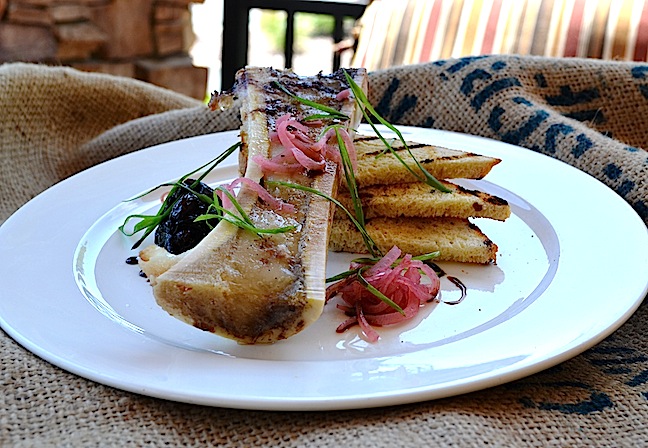 PIG &
PICKLE
PIG &
PICKLE
2922 North Hayden Road
Scottsdale, AZ
480-990-1407
pigandpickle.com
Meat,
salt, pepper, meat, chilies, meat, fat, innards, meat.
That about describes the over-the-top
carnivorous fare at the appropriately named Pig &
Pickle. It’s a big, gregarious room with
the atmosphere of a gastropub set within--as are so
many restaurants in the Valley--a drab shopping
center.
It’s hard
not to have a good time here, but wear stretch pants.
This is not food you want to be anywhere near if
you’re even thinking of going on a diet. To that
end you’ll dine very well indeed, starting off with
items like a pork liver and caramelized onion dish
with pickled fennel, or an array of housemade
charcuterie with pickles (they are serious about their
pickles!).
Braised, very juicy duck leg (below) came on wild rice and quinoa
salad 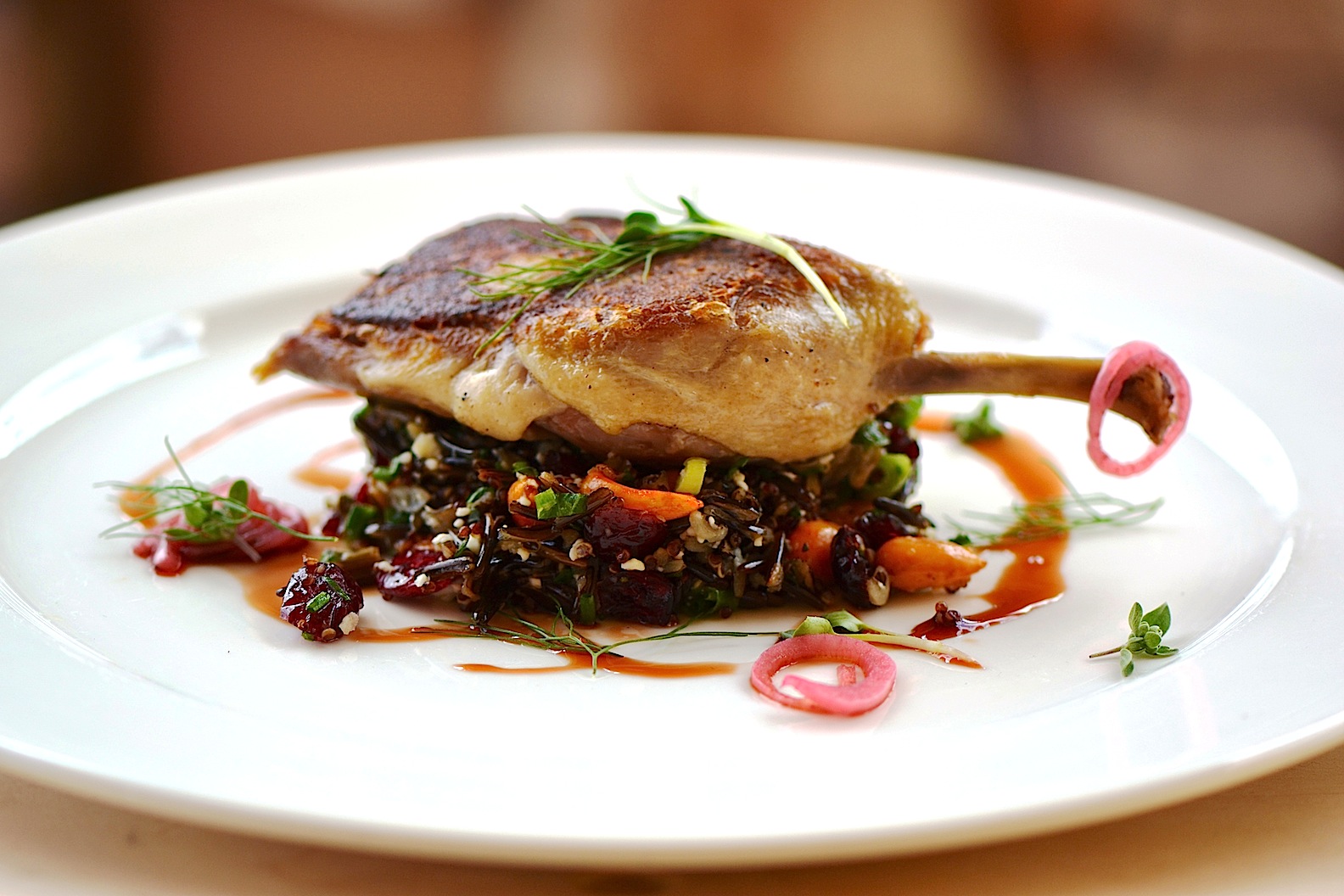 with almonds
and cranberry gastrique
and the gilding of feta cheese, while porchetta was
accompanied by a hefty portion of succotash and three
bean salad. The overproduced pretzel-crusted
chicken with smoked tomato ratatouille--with an “add
on” of foie gras--didn't work, but I loved the hefty
cheeseburger here--as juicy and flavorful as “custom
ground” beef can possibly be. (There is, actually, a
vegetarian green curry with basmati, lentils, Savoy
cabbage, Greek yogurt and winter squash on the menu.)
with almonds
and cranberry gastrique
and the gilding of feta cheese, while porchetta was
accompanied by a hefty portion of succotash and three
bean salad. The overproduced pretzel-crusted
chicken with smoked tomato ratatouille--with an “add
on” of foie gras--didn't work, but I loved the hefty
cheeseburger here--as juicy and flavorful as “custom
ground” beef can possibly be. (There is, actually, a
vegetarian green curry with basmati, lentils, Savoy
cabbage, Greek yogurt and winter squash on the menu.)
Desserts are suitably gloppy and good--seared carrot
cake with whipped goat’s cheese, black pepper caramel
and golden raisins, and a fine Mississippi mud cake
with--ready?--fudge filling, marshmallow fluff and
praline ice cream, which will give you a sugar rush to
last till dawn.
Pig
& Pickle pretends to nothing more than the service
of big grub, generous cocktails, a lotta beer, and
music, and if you’re up for that, this is your
place. And trust me on the stretch pants.
Open daily for dinner, from 4 PM; Appetizers $5-$12, main courses $14-$27.
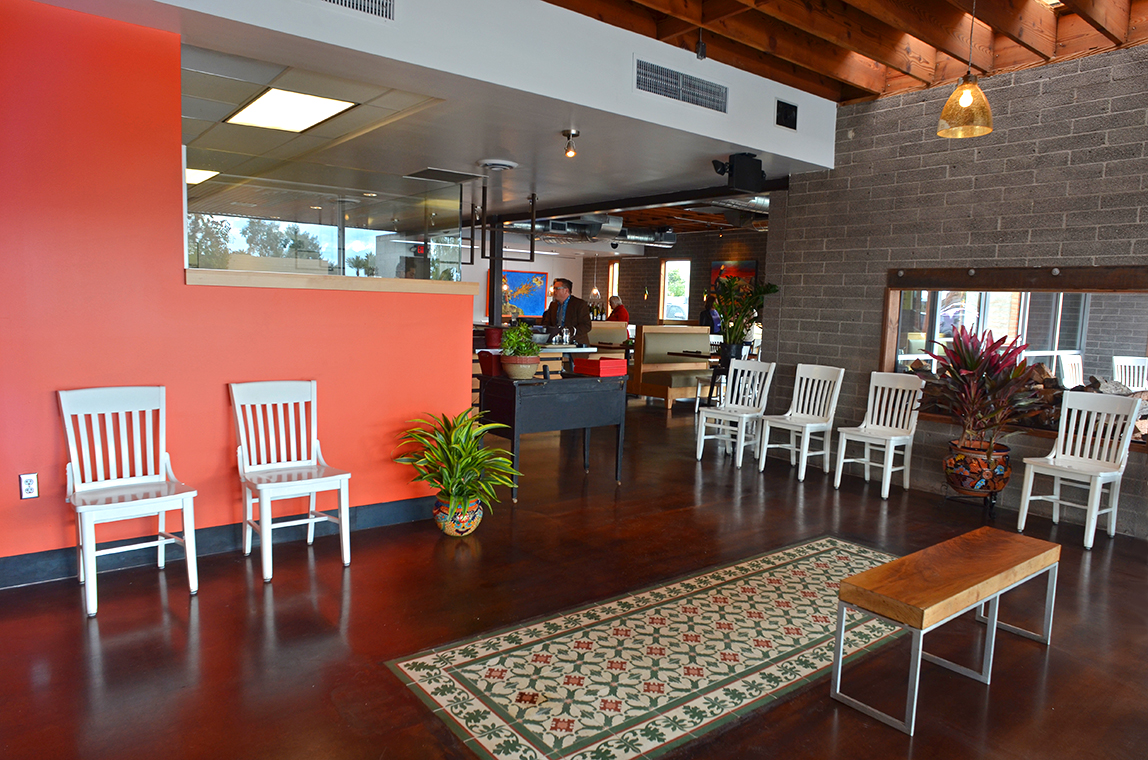
OTRO CAFÉ
6035 N 7th Street
Phoenix
602-266-0831
otrocafe.com
I was a big fan of Doug
Robson’s first restaurant, Gallo Blanco,
where he was doing riffs on regional Mexican food hard
to find anywhere else in the Valley of the Sun at that
time, three years ago. At the time I wrote, “The
trouble with most Mexican street food, including in
Phoenix, is that the cooks just don’t use first-rate
ingredients. Robson does, most sourced locally from
area farmers, and it shows in the distinctive flavors
he achieves in every dish.” That’s certainly the case
at his new place, Otro Café.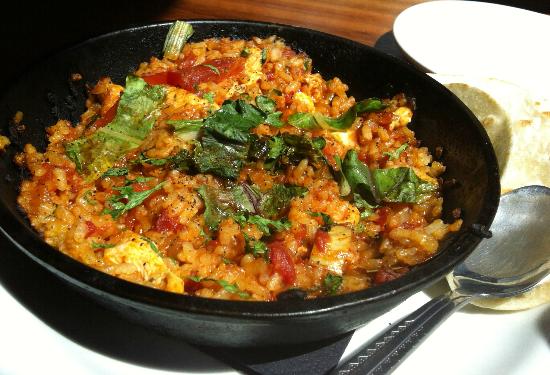
Robson’s
bloodlines run to Mexico, France, England and Vietnam,
which he can hardly ignore when he cooks. Otro
Café sticks closer to the simpler traditions of
regional Mexican food, like tacos filled with achiote-marinated
grilled shrimp, and a pollo en mole
negro. The tacqueria part of the menu features
five items, and I loved the al pastor
with juicy pork, pineapple, achiote adobo,
and tomatillo salsa.
I’m not a
big fan of Spanish paella, but Robson gives his some
real kick, Mexican style, with chicken, pork and
plenty of chorizo for spark (right).
He serves
breakfast all day, and I can well imagine coming here late at night or early
morning, feeling a little worse for wear, and being
restored to something like normalcy by chowing down on
Robson’s chilaquiles
rojas ($9) or huevos rancheros
($7). And
I’m sure your waitress will be ready with the hot
coffee.
Open daily for breakfast, lunch and dinner; appetizers $3-$9, main courses $9-$15.
❖❖❖
NEW
YORK CORNER
By John Mariani
Photos by
Evan Sung
NERAI
55 East 54th Street (off
Park Avenue)
212-759-5554
nerainyc.com
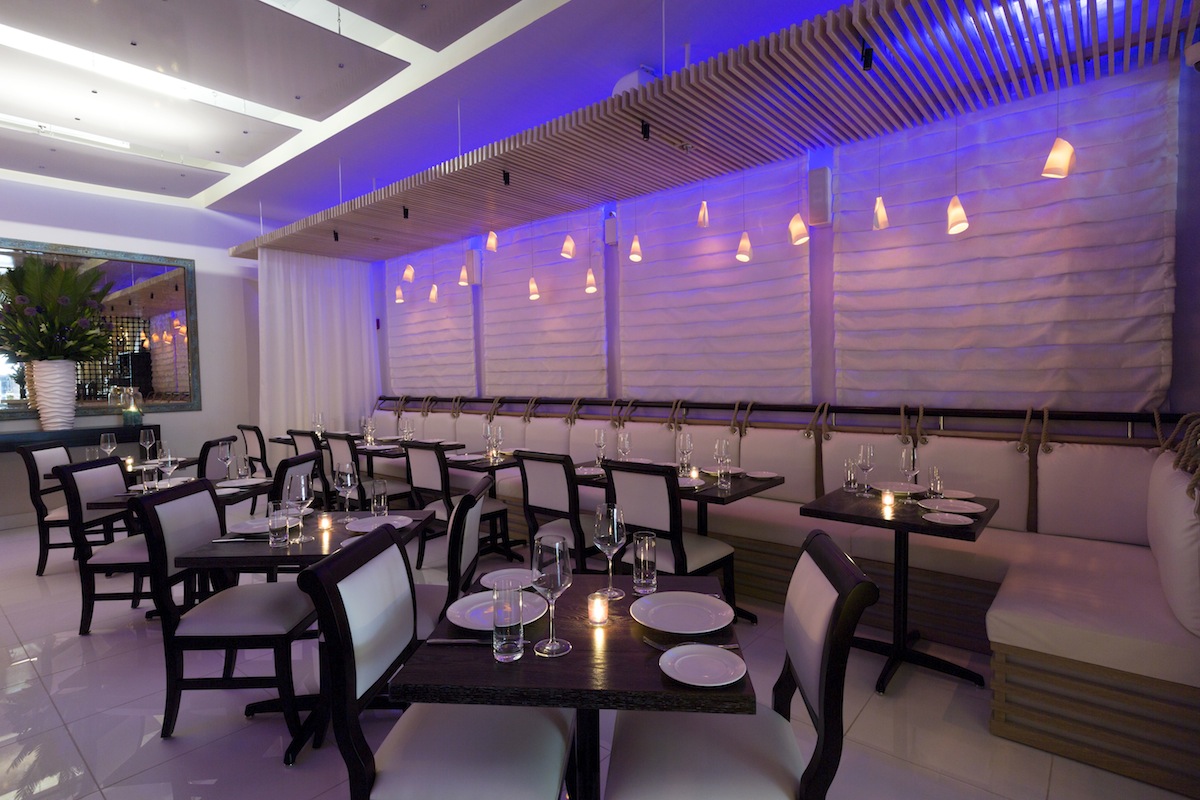 NYC is hardly bereft of
good Greek restaurants, but the new Nerai is easily
the best to have opened since Anthos back in 2007
(since closed).
NYC is hardly bereft of
good Greek restaurants, but the new Nerai is easily
the best to have opened since Anthos back in 2007
(since closed).
The latter was Chef Michael
Psilakis’ thoroughly modern conception of Greek
food, of a kind that would be difficult to find
even in the more modern restaurants in Athens.
At Nerai
there are co-executive chefs here--Chris Christou
(formerly at Per Se, Corton, and Ai Fiori) and Ioannis
Markadakis (from Vezene in Athens)--and, while they
don’t take the high leaps Psilakis did at Anthos,
their cuisine adapts the finest traditions of Hellenic
cuisine and refines them in ways no other Greek
restaurant in NYC is currently attempting.
On the night I dined at the
elegantly appointed bi-level restaurant, it was with
an interior designer friend who pronounced the
marine-like décor exceptionally beautiful,
especially the aqua-green lighting that played softly
from the ceiling onto folds of white drapery-like
fabric. But if you look at the attached photo,
the lighting is a garish violet color of a kind you’d
find in an Atlantic City lounge. I’ve learned that the
lighting is changed from night to night, and I shudder
to think of some of the unappealing colors that might
obtain. I don’t know if they take requests, but maybe
you can beg them to turn on the gorgeous blue-green
lights.
Upstairs is very charming too, more
subdued in décor, and there is a lively bar up
front. I cannot help but comment on the
hostesses at Nerai, who are as cordial as they are
comely. Indeed, every one of the staff is very
attentive. When our waiter asked if he could get us
anything to begin, I joked that the 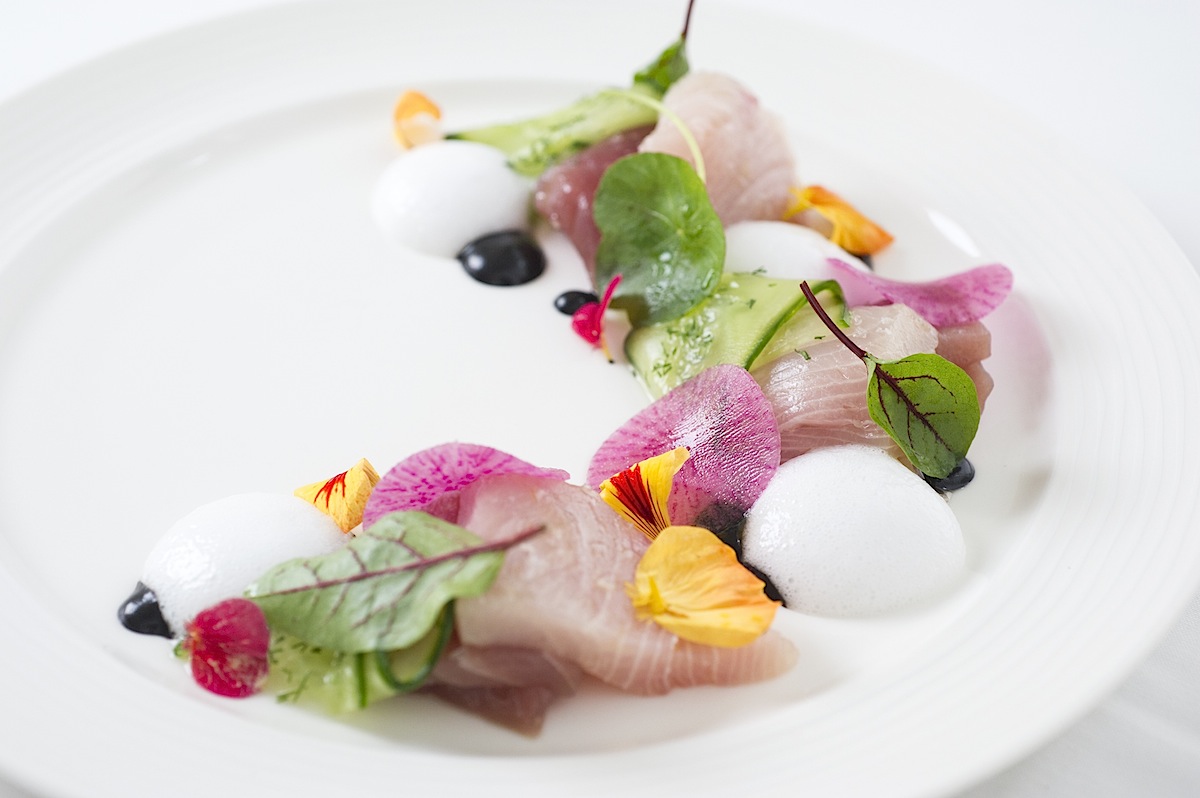 night air had
frozen my fingers and said, “Yes, hot water!” One
minute later he brought me a finger bowl of hot water.
night air had
frozen my fingers and said, “Yes, hot water!” One
minute later he brought me a finger bowl of hot water.
The 137-label wine list is 40
percent Greek, with some unusual selections like the
Assyrtiko de Milos 2004 from Santorini, a charmingly
aromatic white wine.
We began
dinner with an array of mezes, including chickpea hummus and
tahini flecked with onion (below); tender fava beans with onion
and mastika
spirits; and a delightfully spicy feta with paprika
and pepper, all accompanied by fine warm pita bread.
Olives, curiously, were set on the table cold.
The starters, as is so often the case in Greek
restaurants, were wonderfully savory, like the superb
duck moussaka with roasted potato and eggplant and
creamy béchamel--the kind of dish that respects
tradition while utilizing unexpected ground duck meat.
Smoked eggplant with roasted red pepper,
ouzo-scented yogurt and sweet parsnip chips showed the
same spark, while grilled octopus with chickpeas and
marinated cucumbers moved the dial with the addition
of a yogurt foam.
A Greek restaurant must be judged
largely on its seafood--which, believe me, in Greece
still tends to be overcooked, but Nerai did an
impeccable job of grilling a lavraki (sea bass), given a
benediction of olive oil and capers. Langoustines--on
the small side--were cooked with white wine and
sweetened by a tomato confit and a little coriander.
We were thoroughly pleased by the hearty short
ribs with youvetsi
(orzo pasta), tomato, aged piave cheese, and the Mediterranean
scent of cinnamon.
At meal’s end one expects the usual
flaky baklava and yogurt, but Markadakis gives as much
attention to desserts as to everything else, rendering
a delicious lavender mousse made with yogurt and
honey, set on pineapple carpaccio with caramelized
pecans. Portokalopita
is a sponge cake filo with orange syrup and
caramelized hazelnuts, though a dark chocolate sorbet
lent nothing to the dish. Saragli are pastries
composed of rolled baklava, very crispy, with almonds,
pistachio and mastika
gelato.
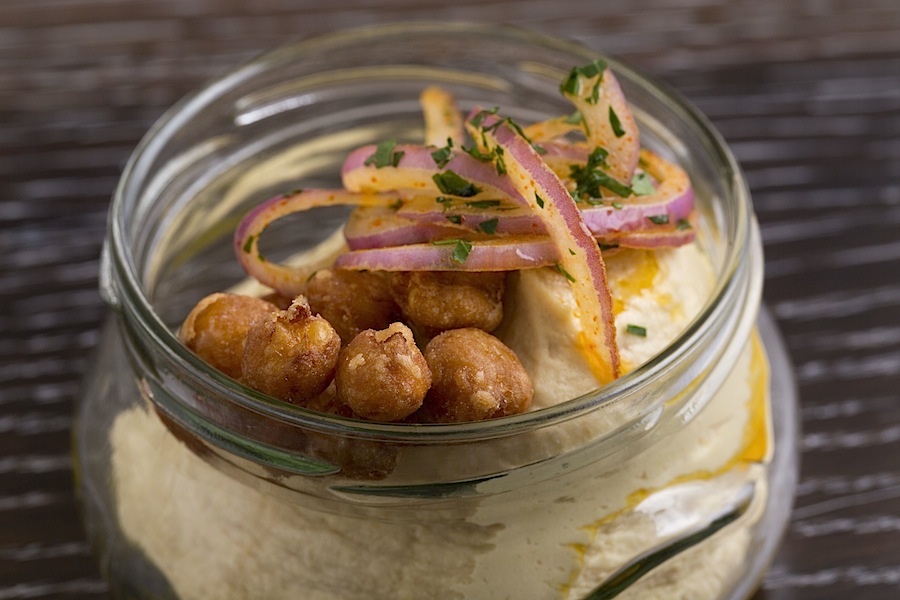
One goes to Nerai
for a truly fine dining experience, and one pays
accordingly: starters range from $12 to $22 and main
courses $26 to $48, with a lobster pasta for two, with
2 ½ pounds of lobster on squid ink linguine, at
$112; whole fish sell by the pound, from $30 to $50.
Nerai is not a taverna, without bazouki players,
fish nets or faded posters of the Acropolis. Instead,
Nerai is admirably at the level of an Italian
restaurant like Marea or a seafood restaurant like
Oceana (whose premises these once were). Quality does
not just count, it costs, and Nerai delivers it with a
panache unique to Greek restaurants in NYC.
Nerai is open for lunch Mon.-Fri., for dinner
Mon.-Sat.
❖❖❖
THE WORLD’S
BEST SELLING
COOKIE MAKES A VERY
CURIOUS CHANGE
By John Mariani
 It’s not like sales of
OREO cookies are lagging.
It’s not like sales of
OREO cookies are lagging.
They have long been and still are the
best-selling cookies in America: more than 345 billion
have been sold since first appearing in 1912 and still
selling 7.5 billion every year.
So the announcement “confirming the
rumors” that two new flavors are being launched in
limited release—about six to eight weeks on the
market—may have more to do with keeping OREO’s image
bright, even hip, when a TV spot, featuring vocals by indie
rockers Tegan & Sara, plays during the Grammy
Awards on Sunday, January 26. At the end of the
commercial, OREO will reveal a one-time-only,
top-secret hash tag for “fans with the fastest thumbs
who tweet” to get a free first taste of the new
cookies, which hit the shelves in February.
The two new flavors are Cookie Dough
and Marshmallow Crispy.
I’ve tasted them and they’re O.K., in the way a
variant of “Surfer Girl” with strings might be, or a
Porsche with fins.
The cookies were likeable, nice crunch, pretty
much the same dark chocolate flavor in the Cookie
Dough sample. The
Marshmallow Crispy one is biscuit color and has
something of the taste of Rice Krispie Treats.
They’re awfully sweet, but then OREOS
never skimped on the sugar content. They are
certainly not an absurd marketing gaffe like New Coke
or Pepsi Clear, and the limited release gives them a
kind of cult status. But after eating a couple of the
new flavors, I didn't feel like gorging on the rest of
the package, as I and millions of fans do with
uncontrolled abandon, with or without a glass or milk,
on classic OREOS.
Indeed, a 2013 study from Connecticut
College showed that, at least for lab rats, OREOS are
as addictive as cocaine, activating the animals’
neurons in their
“pleasure center” in the same way heavy drugs
do. “I haven’t touched an OREO since doing this
experiment,” the school’s neuroscience assistant
professor Joseph Schroeder said after getting the
results. Awesome.
OREOS have had a long time to grow on
us. They
weren’t the first
sandwich cookie—that was Hydrox in 1908, followed
four years later with a very similar cookie developed
by a grocer named S.C. Thueson, who named it OREO, a
name delectably, elusively mysterious, since nobody,
not even Nabisco Biscuit Company that owns the
trademark, knows what it means. It has been suggested
that the name may derive from the French word for
“gold,” or,
 because the original package
had the product name in gold. Another guess is that
the word is from the Greek for “mountain,” the shape
of which early test batches of OREOs resembled. Both
stories sound ridiculous.
because the original package
had the product name in gold. Another guess is that
the word is from the Greek for “mountain,” the shape
of which early test batches of OREOs resembled. Both
stories sound ridiculous.
But
the catchy name itself was easy to stick in people’s
minds. It
had a happy sound, like a pet’s name, but one that
sounded vaguely like a symbol for a secret society
that passed out the cookies, with their odd imprints
of what looks like four-leaf clovers and a UFO with an
antenna, in low-lighted ritual halls, chanting “OREO,
OREO, OREO…” (Hydrox, which sounds like a cleaning
solution, went through various hands, was
discontinued, had name changes, and its most recent
owner, Kellogg’s let the brand drop.) The name
OREO is so well known that it even became pejorative
slang, both for a black person emulating whites, and
for a sexual threesome of two blacks and a white in
between.
The appeal of the OREO is not that
it’s a filled cookie—nothing new there—but that it has
a perfect balance of very dark, almost bitter
chocolate, very crisp wafers and pure white cream  center, so it
is the only cookie that demands a certain decision
about how to eat them: either you take a bite or you
twist off the top cracker and lick off the cream
filling.
center, so it
is the only cookie that demands a certain decision
about how to eat them: either you take a bite or you
twist off the top cracker and lick off the cream
filling.
Such behavior always comes up as a
topic of conversation—the twister considered mildly
deviant—and I suspect more than one divorce lawyer has
heard one party complain that “I loathe the
way he eats his OREOs! It drives me goddamn crazy!” Cookies in
bed. Not good.
OREO’s triple pleasure and twist-off
top is what first beguiles children, but, however many
thousands of the cookies you eat in your lifetime,
those pleasures are recalled, along with the way the
cookie softens in milk and how the crumbs bob in the
milk, offering a fourth pleasure to the exercise of
eating an OREO.
It's something you never forget, the way most of us
do about eating SPAM or TV Dinners or Chef Boyardee
spaghetti.
So whether or not Americans need a
new OREO flavor—these two are not the first ever
marketed—seems moot.
Variety is not such a bad thing—tassels on
loafers, different color Post-Its, a new James Bond
actor—but as with a few very good things in life, what
was perfect when we were five should be just as
wonderful when we’re fifty.
❖❖❖
NOTES FROM
THE WINE CELLAR
WHAT'S THE
OUTLOOK FOR WINE BUYING IN 2014?
By John Mariani
 The buying and
selling of wine has two long traditions: on the
one hand, it is a rough-and-tumble game of selling
as much mediocre wine and sheer plonk as possible
to a customer base that looks first and only at
price; on the other hand, it has for a century
been an elitist business in which price is
determined by supply and demand of the most
hyped-up wines in the world.
The buying and
selling of wine has two long traditions: on the
one hand, it is a rough-and-tumble game of selling
as much mediocre wine and sheer plonk as possible
to a customer base that looks first and only at
price; on the other hand, it has for a century
been an elitist business in which price is
determined by supply and demand of the most
hyped-up wines in the world.
These
days, however, while the volume sales continue to
tilt one way or the other in half-percentage points,
the upscale wine market has gone through boom and
bust periods right along with the economy in
general.
Prior to
2008 California cult wines like Screaming Eagle
Cabernet Sauvignon were selling for hundreds of
dollars a bottle and the rarest of red Burgundies,
like Romanee-Conti, sold for thousands, very often
to people who had no intention of ever drinking
them. The futures market, through which you
pay for wines at a set price before they actually
come into the market, seemed a good bet back then.
But the
crash of 2008 put the wine market into turmoil,
saved only by the opening of a Chinese market for
fine wines that has rocked sales at auction for
prestigious Bordeaux and Burgundy sold to China’s
new millionaires. Then, in the past year, top
Chinese officials directed such lavish excesses to
be reigned in, so things began to get shaky in the
fine wine market. The auction market went up and
down in 2011 and 2012, but U.S. sales to consumers
last year hit a new high of 360.1 million nine-liter
cases for a value of $34.6 billion.
What to
make of all this turmoil in 2014? First of all,
those sky-high U.S. sales figures, as with the wine
sales figures of all countries, are not based on
premium bottles ($10 and above) but on cheap wines
selling for $5 to $10 a bottle, with chardonnay
still the most popular varietal. And, while U.S.
sales may in fact rise in 2014, with 100 million
Americans drinking the stuff, those sales are
unlikely to be of $25 merlots and $100 cabernets.
Even so, the U.S. is still behind Ireland, Canada
and Iceland in per capita consumption.
In France
and Italy, wine consumption has dropped
precipitously among young drinkers. In 1980, 51
percent of the French drank wine every day; in 2010
it was only 17 percent and 38 percent never drink
wine at all. Italians’ wine consumption per
capita has dropped by 50 percent.
It came
as a laughable surprise, then, when a recent article
in London’s Guardian
newspaper asserted there was now an actual scarcity
of wine in the world, especially since the Chinese
and Indians had entered the buyer’s market.
“There is
no scarcity, but with global consumption rising,
supplies will be tighter,” says Scott Shellady, CEO
of Bradford Capital Management, who also advises on
wine portfolios for clients. “All commodity markets
have had to deal with China in their marketing
plans. With more and more Chinese traveling and
being introduced to Western products, supplies will
be affected. It's the same with beef and grain.
While our hybrids and production capabilities have
been growing at an arithmetic pace, the demand side
of the equation has been growing at a geometric
pace. Asia will have to be dealt with when it comes
to Western production.”
Still, Shellady says he
would steer clear of the Chinese wine market for the
time being, because there is so much faking and
forgery  of wines
occurring there--mainly with the very
top-of-the-line wines from Bordeaux and Burgundy,
but also popular wines from Italy and Spain.
“I was in Beijing recently,” a producer of a
grand cru Burgundy told me, “and I was amazed to see
that my wines were being counterfeited, but I was
shocked to see how widespread it was.”
of wines
occurring there--mainly with the very
top-of-the-line wines from Bordeaux and Burgundy,
but also popular wines from Italy and Spain.
“I was in Beijing recently,” a producer of a
grand cru Burgundy told me, “and I was amazed to see
that my wines were being counterfeited, but I was
shocked to see how widespread it was.”
As for
the auction market right now, it’s very much caveat
emptor because of the increase in forged wines. Just
last month wine seller Rudy
Kurniawan, who in 2006 sold $24.7 million worth of
wine at an Acker, Merrall & Condit auction,
was found guilty by a federal jury of selling
counterfeit wines and defrauding a finance
company--the first such case in U.S. history. He
may be sentenced to up to 40 years in jail.
“Everyone’s being much more careful in the auction
market,” says Peter D. Meltzer, auction columnist
for Wine
Spectator and author of Keys to the
Cellar: Strategies and Secrets of Wine Collecting.
“The auction houses will be more diligent and the
buyers will ask more questions as to where the wines
have been all their lives. But overall I think the
market will be calmer and prices won’t rise
dramatically, largely because there was something of
a glut with the 2009 and 2010 vintages.”
For
the
average wine drinker, however, I see far more good
wine available at stable prices than ever in 2014.
With so much competition now offered by
quality South American wineries, especially
Argentina, Chile, and, now, Uruguay, producers in
Spain, Italy, Australia and New Zealand will be
forced to keep prices down. France has already
driven prices down for export wines below the grand
cru rankings.
Also look
for quality wines to come from Portugal and eastern
European countries like Greece, even Serbia, and,
finally, good South African wines priced to sell.
For everyday wines, 2014 will be a buyer’s
market.
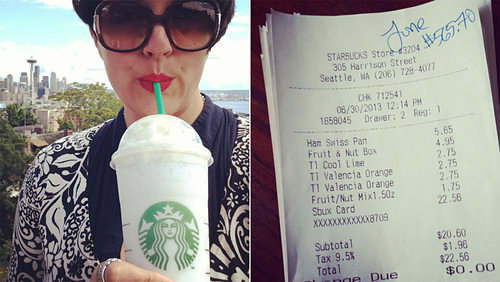
FIRST EXAMPLE OF TRULY
WRETCHED EXCESS IN 2014
A Seattle blogger who calls herself Beautiful
Existence (left)
spent an entire year eating only from Starbucks and
its affiliates like Tazo
Tea and Evolution
Fresh.
OH, HOW WE LOVE
THE SMELL OF
BILE IN THE MORNING!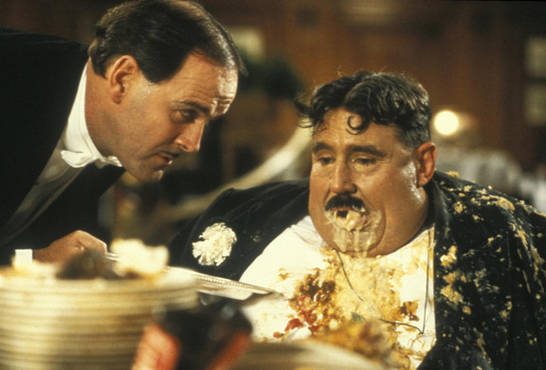
"Right now
there's a luxe
food economy, focused on a couple of London
postcodes, which is entirely supported by a grotesque,
preening, Louboutin-heeled, gold-plated
iPhone-carrying, plastic-crashing,
Bugatti-driving, natural resource-pillaging
excuse for humanity that floats like some
gold-flecked scummy head on the warm beer of the rest
of an economy simply trying to make do. [Dining out
with such people] is a complete and
utter hell." --Jay Rayner, "Posh Restaurants
Wasted on the Rich," The Observer.
❖❖❖
Any of John Mariani's
books below may be ordered from amazon.com.
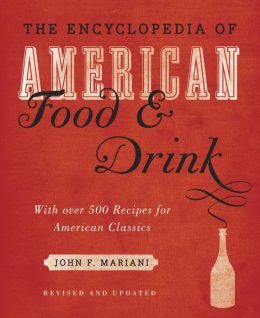 |
The Encyclopedia of American Food
and Drink by John F. Mariani
(Bloomsbury USA, $35) Modesty forbids me to praise my own new book, but let me proudly say that it is an extensive revision of the 4th edition that appeared more than a decade ago, before locavores, molecular cuisine, modernist cuisine, the Food Network and so much more, now included. Word origins have been completely updated, as have per capita consumption and production stats. Most important, for the first time since publication in the 1980s, the book includes more than 100 biographies of Americans who have changed the way we cook, eat and drink -- from Fannie Farmer and Julia Child to Robert Mondavi and Thomas Keller. "This book is amazing! It has entries for everything from “abalone” to “zwieback,” plus more than 500 recipes for classic American dishes and drinks."--Devra First, The Boston Globe. "Much needed in any kitchen library."--Bon Appetit. |
"Eating Italian will never be the same after reading John Mariani's entertaining and savory gastronomical history of the cuisine of Italy and how it won over appetites worldwide. . . . This book is such a tasteful narrative that it will literally make you hungry for Italian food and arouse your appetite for gastronomical history."--Don Oldenburg, USA Today. "Italian
restaurants--some good, some glitzy--far
outnumber their French rivals. Many of
these establishments are zestfully described
in How Italian Food Conquered the World, an
entertaining and fact-filled chronicle by
food-and-wine correspondent John F.
Mariani."--Aram Bakshian Jr., Wall Street
Journal.
"Equal parts
history, sociology, gastronomy, and just
plain fun, How Italian Food Conquered the
World tells the captivating and delicious
story of the (let's face it) everybody's
favorite cuisine with clarity, verve and
more than one surprise."--Colman Andrews,
editorial director of The Daily
Meal.com. "A fantastic and fascinating
read, covering everything from the influence
of Venice's spice trade to the impact of
Italian immigrants in America and the
evolution of alta cucina. This book will
serve as a terrific resource to anyone
interested in the real story of Italian
food."--Mary Ann Esposito, host of PBS-TV's
Ciao
Italia. "John Mariani has written the
definitive history of how Italians won their
way into our hearts, minds, and
stomachs. It's a story of pleasure over
pomp and taste over technique."--Danny Meyer,
owner of NYC restaurants Union Square Cafe,
Gotham Bar & Grill, The Modern, and
Maialino.
|
 |
 |
 |
 |
 |
 |
 |
 |
 Everett Potter's Travel Report:
Everett Potter's Travel Report: 
 Eating Las Vegas
is the new on-line site for Virtual Gourmet
contributor John A. Curtas., who since 1995
has been commenting on the Las Vegas food
scene and reviewing restaurants for Nevada
Public Radio. He is also the
restaurant critic for KLAS TV, Channel 8 in
Las Vegas, and his past reviews can be
accessed at KNPR.org.
Click on the logo below to go directly to
his site.
Eating Las Vegas
is the new on-line site for Virtual Gourmet
contributor John A. Curtas., who since 1995
has been commenting on the Las Vegas food
scene and reviewing restaurants for Nevada
Public Radio. He is also the
restaurant critic for KLAS TV, Channel 8 in
Las Vegas, and his past reviews can be
accessed at KNPR.org.
Click on the logo below to go directly to
his site.

Tennis Resorts Online: A Critical Guide to the World's Best Tennis Resorts and Tennis Camps, published by ROGER COX, who has spent more than two decades writing about tennis travel, including a 17-year stretch for Tennis magazine. He has also written for Arthur Frommer's Budget Travel, New York Magazine, Travel & Leisure, Esquire, Money, USTA Magazine, Men's Journal, and The Robb Report. He has authored two books-The World's Best Tennis Vacations (Stephen Greene Press/Viking Penguin, 1990) and The Best Places to Stay in the Rockies (Houghton Mifflin, 1992 & 1994), and the Melbourne (Australia) chapter to the Wall Street Journal Business Guide to Cities of the Pacific Rim (Fodor's Travel Guides, 1991).


MARIANI'S VIRTUAL GOURMET
NEWSLETTER is published weekly. Editor/Publisher: John
Mariani.
Contributing Writers: Christopher Mariani, Robert Mariani,
John A. Curtas, Edward Brivio, Mort Hochstein,
Suzanne Wright, and Brian Freedman. Contributing
Photographers: Galina Stepanoff-Dargery,
Bobby Pirillo. Technical Advisor: Gerry McLoughlin.
© copyright John Mariani 2014
